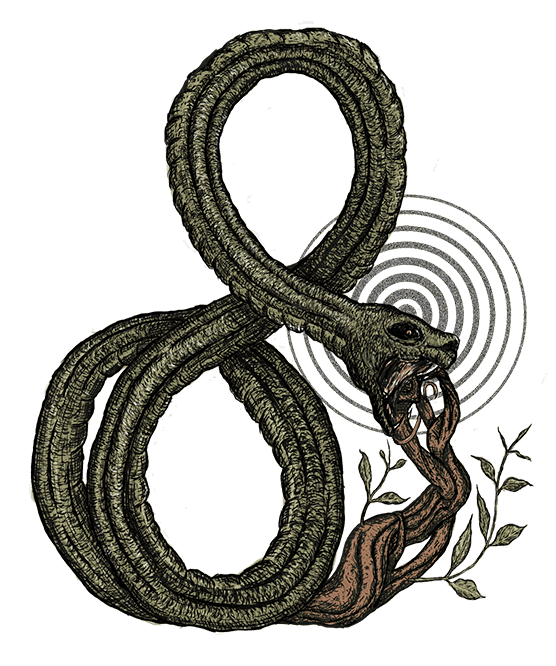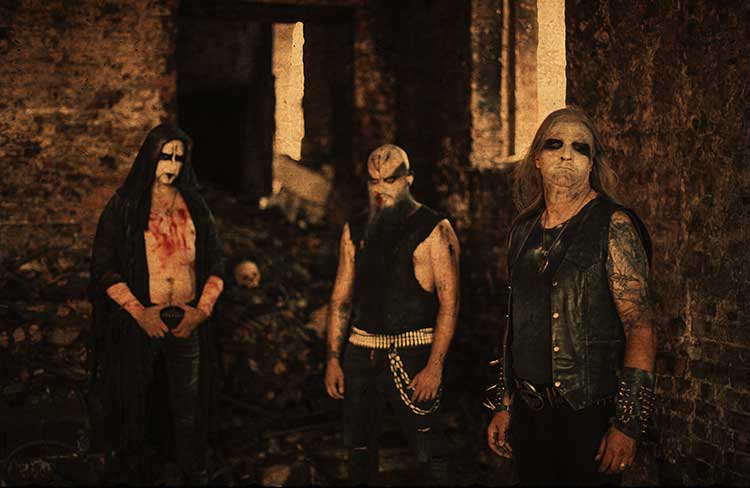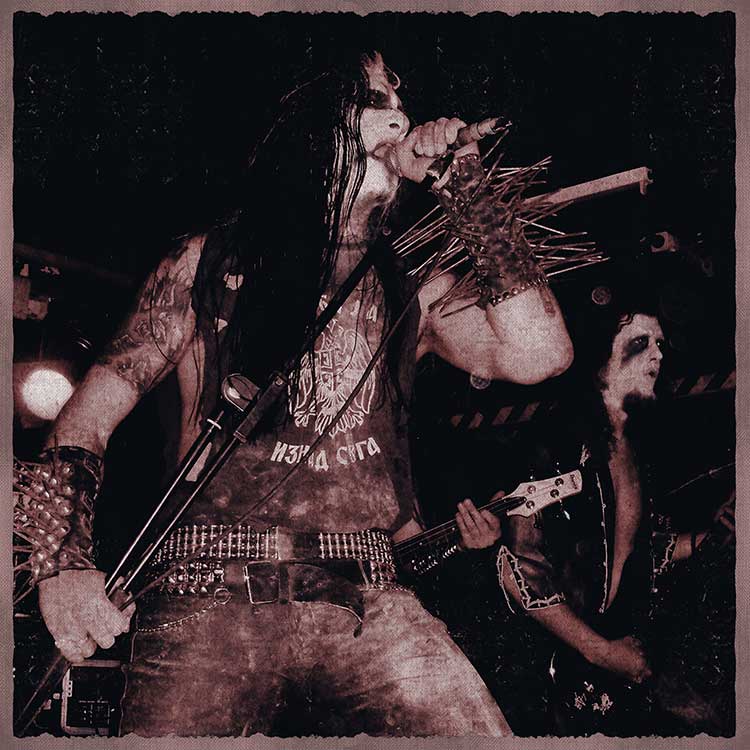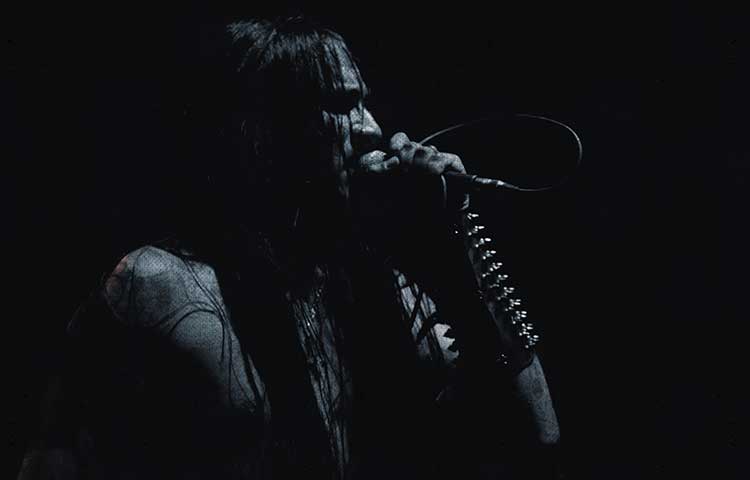The Stone
2024-02-21
by Niklas Göransson
Serbian black metal veterans The Stone weave echoes of the past into fury for the present. Emerging from the mid-90s, marred by scars of conflict, they carved out a path through cacophonies of bombs and the silence of ruins.
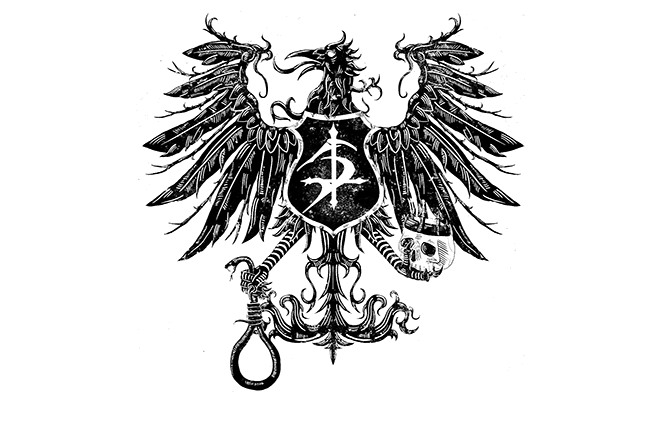
KOZELJNIK: Music has a universal language that I believe speaks to our moods and emotions. To truly connect with art, we need to engage with it on an intimate level. Some songs might resonate immediately, but more often it takes repeated listens to find the right chemistry or perfect match. “Kosturnice” is a prime example of this, inviting listeners to immerse themselves deeply into its sonic spheres.
GLAD: In my humble opinion, “Kosturnice” represents the pinnacle of our career thus far. I know musicians always say their latest work is the best one yet, but I truly mean it. The exceptional production and mastering – courtesy of our drummer and long-time collaborator Honza Kapák at Hellsound Studio – create an unrestrained and dense wall of sound ready to take your head clean off.
“Kosturnice” – the ninth album by Serbian black metal band THE STONE – was released by Immortal Frost Productions in March 2021. The move to Immortal Frost follows a stint of self-releasing via Mizantropeon Records. Bands operating their own label is an approach which seems to have gained popularity in recent years following the success of MGŁA.
KOZELJNIK: Popular move or not, I think most bands have a natural desire to take control of their careers by acquiring the necessary tools to publish their own music. This isn’t a recent development, and it’s not just because of MGŁA. In any case, after “Nekroza” (2014) we found ourselves staying with the same record label for too long.
Between 2006 and 2014, THE STONE released four albums on Germany’s Folter Records.
KOZELJNIK: During that period, we received several offers from other interested parties – however, we ultimately decided to take the leap and start our own label, walking side-by-side with all the risks such an undertaking might carry. Our initial focus was on releasing THE STONE’s eighth full-length album, “Teatar apsurda”, and later we also released an EP.
“Teatar apsurda” was released by Mizantropeon Records in December 2017. One year and four months later came a seven-inch called “Kruna praha”.
GLAD: Although “Kosturnice” is somewhat rawer and perhaps less accessible than its predecessors, it represents a leap forward in terms of sophisticated musicianship and innovative technical solutions. Lyrically, “Kosturnice” delves into themes of omnipresent death from a multifaceted perspective… ritual sacrifice, death of the soul through spiritual degradation, the depravity of war, and the looming threat of nuclear apocalypse – it’s all in there.
“Kosturnice” means ‘ossuaries’ in Serbian and is used as a metaphor for a world filled with death. Not exactly a novel topic for a black metal album, but THE STONE’s approach is perhaps somewhat more mature than what one is used to.
GLAD: I don’t think we’ve invented something groundbreaking either, nor was it our aim to do so. When it comes to black metal – or even rock ‘n’ roll – everything has already been done in one form or another. Nonetheless, what makes THE STONE special is how we utilise the traditional black metal framework and convey it with a unique Slavic punch. This especially shines through if you can read and fully understand what the fuck we’re singing about.
Serbian is a South Slavic language that uses both the Cyrillic and Latin alphabets. It shares a lot of vocabulary and grammar with Bosnian and Croatian, and speakers thereof can often communicate without difficulties.
GLAD: While themes of death, pessimism, and misanthropic existentialism have always been a source of inspiration for THE STONE, it’s not as if we constantly dwell on these matters in our daily lives. I prefer to live in the present without obsessing over that which awaits us in the Great Beyond. After all, life is short – and all of us will eventually find out what lies behind the veil.
Both Kozeljnik and Glad were born at a time when Serbia was still part of the Socialist Federal Republic of Yugoslavia. The country adopted a different brand of socialism than that of the Soviet Union, and – unlike most communist nations in Central and Eastern Europe – did not align itself with either side in the Cold War. As such, Yugoslavian society had a higher tolerance for Western culture.
GLAD: Some countries of the communist bloc banned or censored metal and hard rock music, but we can attest to the fact that this wasn’t the case in Yugoslavia; you could legally purchase or order most kinds of music. During that time, religious or national affiliations were not as prominent in the Yugoslav pulse.
Back in the 1980s, Yugoslavia comprised six different South Slavic republics: Macedonia, Bosnia and Herzegovina, Montenegro, Croatia, Slovenia, and Serbia. Furthermore, there were significant minorities of Albanians, Hungarians, Roma, and Turks residing throughout the country.
GLAD: We grew up in a diverse, multi-ethnic society similar to the one you were born into in Sweden; it was only with the fall of communism, from Tallinn to Bucharest, that radical national ideologies began taking shape. And with the war and subsequent breakup of the old system in the 90s, as well as the sanctions and embargos imposed on Serbia, getting an original tape or vinyl started to look a lot like ‘mission impossible’.
What we know today as the Yugoslav Wars began in June 1991 when both Croatia and Slovenia declared independence. The Yugoslavian federal government, under the leadership of Serbia, opposed this move and sent troops to the newly formed countries.
GLAD: When shit hit the fan in ‘91, I was only ten years old. Even though you are just a kid, you’re still old enough to understand what’s happening, right? Our small town was located relatively close to the Croatian border, and I recall seeing tanks, artillery, army personnel, and militias passing through on their way to Vukovar.
The city of Vukovar became one of the first theatres in the Yugoslav Wars, as Croatian forces fought to repel the Yugoslav People’s Army and Serbian paramilitary units. The siege lasted for three months before the defenders were overwhelmed and forced to surrender.
GLAD: I witnessed plenty of fucked up things during this period. Across the street from where I lived, there was an old-school bar that reservist soldiers and volunteers would frequent before being deployed to the front. Every once in a while, someone would end up knifed or shot in a drunken brawl. On several occasions, I woke up to the sound of machine-gun fire – presumably from AK-47s – in the middle of the night. In a separate instance, a very drunk idiot threw a hand grenade into the bar; that’s when they finally had to close up shop. Ah, such fun times.
The following year, 1992, a fifteen-year-old Kozeljnik – who lived in Belgrade, the capital of Serbia – started a death metal band called RANCID DEATH. That’s when things really started kicking off over there.
KOZELJNIK: To be precise, the main battlefields were located on the soils of today’s Croatia and Bosnia. Our parts of Serbia, Belgrade in particular, were far from the frontlines. Of course, the far-reaching blare of war was present at every corner of the country; nobody was immune, regardless of ethnicity or age. But we were young, hungry for metal music, and infected by its death and black prefixes.
RANCID DEATH was soon renamed to NEFAS, following which they recorded a rehearsal tape. Shortly thereafter, in November 1993, Kozeljnik played his first-ever live show with the band.
KOZELJNIK: In hindsight, I must admit that as young metal worshippers, we were completely oblivious to the pathological, morbid, and grim reality that surrounded us – even though it was punching our subconscious and fuelling creativity. We just embraced all the madness and chaos and channelled its energy into the art we adored and lived for. On the other hand, as the war devoured the whole region, it became increasingly difficult to keep the band alive under the very, very poor conditions we lived in.
The same year, in 1993, the UN imposed austere sanctions on Serbia, including embargos on various imports such as oil – which severely crippled industries and the transportation sector – as well as medical supplies. This also affected access to metal music.
GLAD: The kids who were just getting into this kind of music, myself included, had to resort to Polish and domestic bootlegs, tape-trading, and the occasional flea market in order to get their hands on something genuinely rare or extreme. But when we actually scored new demos or albums, it really meant something. We’d listen with utmost dedication and make copies for all our friends. In a way, the struggle to obtain these records only made them more valuable and appealing.
KOZELJNIK: I guess when such nostalgic reminiscence brings melancholy, then we are dealing with the fact of being old enough to be triggered emotionally by times buried in our past. I’m not sure the new generations can fully comprehend these old values, or the impact that metal music had on people’s lives during those times – both spiritually and physically – and how it changed the trajectory of artistic expression.
Kozeljnik founded his first black metal band, STONE TO FLESH, in ‘96. At the time, the Yugoslav Wars had largely ended with the 1995 Dayton Agreement. The Socialist Federal Republic of Yugoslavia was dissolved and gave way to the Federal Republic of Yugoslavia, now consisting only of Serbia and Montenegro.
The new country came into existence plagued with hyperinflation, unemployment, and a large national debt which, in turn, soon led to widespread poverty and civil unrest. Despite societal hardship, Kozeljnik put together a line-up and recorded a demo called “Serbian Woods” in February 1997.
KOZELJNIK: Finding a rehearsal place in Belgrade wasn’t difficult as there were numerous studios around – remnants of the 80s Yugoslav rock scene. Nor was it hard to recruit members, as our artistic circle had several musicians with their own bands up and running. So, in general, the base of enthusiasts existed right from the start. However, our lives were dictated by survival under radical circumstances, so keeping these individuals and their interests aligned with those of the band was a challenge.
After the Dayton Agreement ended the war in Bosnia and Herzegovina, making it a sovereign federal state, many Serbs relocated to the Serbian province of Kosovo. Soon thereafter, the Kosovo Liberation Army – a paramilitary organisation dominated by ethnic Albanians – launched a series of attacks on both civilian and official targets. The campaign intensified in 1998, prompting a military response by the Serbian government; this conflict became known as the Kosovo War.
In 1999, as STONE TO FLESH prepared to record their debut album, “Some Wounds Bleed Forever”, Belgrade was bombed by NATO.
GLAD: I’ll never forget when they broke it on the news in late March 1999; the whole thing seemed utterly surreal. I mean, I couldn’t believe that the Americans and NATO were about to bomb a sovereign nation without a mandate from the UN. The first bombs fell that evening. Once the reality check kicked in, I guess all of us just entered some kind of survival mode and focused on once more enduring what was being thrown at us by the ‘civilised’ West.
KOZELJNIK: During those months of almost constant bombardment, living in the proximity of devastation was an everyday occurrence. I vividly remember the nightly raids, during which I was at the highest peak of a neurotic state of mind – lying in bed, waiting for a bomb to erase me from the face of the earth. Whenever the sirens woke me up, my ears were the only weapon I had as I listened for the high-frequency sound of incoming missiles.
GLAD: In early May 1999, my mother’s sister, Aunt Liljana, was killed when NATO targeted a military facility over a mile away. A piece of the bomb landed in their backyard, where she was standing with her husband and young daughter. The autopsy report showed that she was hit directly in the heart by a massive, crescent-shaped shrapnel. Died on the spot. If I were superstitious and didn’t know any better, I’d say that the circumstances under which she perished very much resembled some ominous, fucked-up shit straight out of a Slavic witchcraft textbook.
KOZELJNIK: One night there was an explosion damn close to my flat – they hit someone’s home just down the street. The next morning, we heard on the news that a pregnant woman had been killed in the very same house. After the bombings ceased, my mother was diagnosed with onset diabetes triggered by the chronic stress she endured in 1999. She passed away in March 2002.
GLAD: Other than these unfortunate events, it is believed that the number of civilian casualties during the ‘Merciful Angel’ campaign surpassed that of the September 11 attacks, although no major Western government or media outlet would ever acknowledge this.
‘Merciful Angel’ is how the seventy-eight days of NATO bombardment became known in Serbia. Some accounts suggest that it is a mistranslation of the official US name, Operation Noble Anvil. Estimates of casualties vary heavily depending on sources – from five or six hundred to several thousand. However, such calculations do not take into account the long-term effects of destroyed infrastructure, displacement of civilians, and emotional scars.
GLAD: If we’re talking about the impact on our collective psyche, I’m not sure we were greatly affected. By then, it was just cherry on the cake after almost a decade of conflict, financial struggle, power outages, skyrocketing inflation, and international sanctions. Once depleted uranium had stopped raining from the sky, most of us simply resumed our lives as before. Then again, no one undergoes such a disaster and emerges unscathed. Afterwards, I recall feeling a certain discomfort whenever I heard a siren. Being subjected to that eerie noise day after day for months on end was akin to Chinese torture.
The bombing campaign forced Serbia to withdraw the Yugoslav security forces from Kosovo. In their stead, NATO troops were deployed to maintain peace and security, and a United Nations interim administration was established to oversee the transition to self-governance.
KOZELJNIK: Looking back now, it’s clear that the NATO aggression of 1999 was the final nail in the coffin of Yugoslavia. Even then, we all knew that this unprecedented act had nothing to do with saving the ‘poor Albanians’ from a humanitarian crisis, but rather served as a convenient excuse to shell the shit out of our country. It was part of a twisted political agenda with the aim of dismantling communist and established socialist regimes in Eastern Europe and replacing them with Western-style democracies – no matter the price.
log in to keep reading
The second half of this article is reserved for subscribers of the Bardo Methodology online archive. To keep reading, sign up or log in below.
